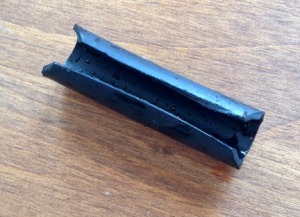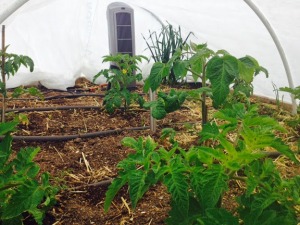Author Archives: Farmer Deb
DIY Pet Safe Lawn Fertilizer: Does it work?
Around that time I came across a book by Jerry Baker, The Impatient Gardener, which contained a recipe for lawn tonic. I tried that a few times, but eventually gave way to convenience and went back to using store-bought fertilizers. It wasn’t until the past few years that I became more concerned with what exactly was IN those bags of grainy chemicals and what they might to do our pets, the wild animals visiting our yard and the environment in general.
I searched the internet for more information about DIY fertilizers, pulled out my old Impatient Gardener and compared notes. It seems the recipe hasn’t changed, but I was curious why those particular ingredients were being used. Just what do they do? I was able to find all of the ingredients at a dollar store, except for the beer. You’ll get several batches from all the ingredients except for the beer and soda, so this tonic is also inexpensive. Once I’ve applied this to my grass, I water with plain water for a while to help it soak in. Here’s the recipe:
Put all ingredients into a one quart hose-end sprayer. I was able to get one from Ace Hardware (“Use 7 ways” says the label) that I could attach to a hose on the input side, another (short) hose on the output side and then add an oscillating sprinkler. If you don’t have an extra hose or sprinkler you’ll just have to stand around for a while and spray your lawn by hand. The book says it will cover up to 2500 square feet and should be used in May and again in late June, but I don’t suppose it would hurt to use it more often if it’s very dry in your area. And of course don’t water during the heat of the day, it’s wasteful and you could scorch your grass.
Do hoop houses really work?
The short answer is “you betcha!” This is my second year of using a hoop house. Last year we just put hoops over one raised bed. I used a plastic drop cloth as the covering and I wasn’t completely thrilled with it. During sunny days, even if it was cold outside, the house would get incredibly hot because plastic doesn’t breathe. But I planted a couple of weeks earlier than advised and all went well.
By the end of summer, the stowed plastic had begun to disintegrate. I had left it outside within quick reach just in case I had to cover the garden during one of our frequent summer hail storms and plastic just isn’t meant to be out in the sun. But the hoop house was successful enough to be encouraging, so we built a second one.
 After doing some internet research, I found this Agribon cold weather row cover cloth that was recommended by a few different sources. I ordered it last winter in anticipation of getting an even earlier planting going this spring. Our “last frost” date here is May 16 and still there are no guarantees. But I decided, after looking at the extended forecast for my area, to throw caution to the wind and plant a whole month early. Crazy! I got busy planting.
After doing some internet research, I found this Agribon cold weather row cover cloth that was recommended by a few different sources. I ordered it last winter in anticipation of getting an even earlier planting going this spring. Our “last frost” date here is May 16 and still there are no guarantees. But I decided, after looking at the extended forecast for my area, to throw caution to the wind and plant a whole month early. Crazy! I got busy planting.
After a week or two we had a few nights that were expected to be near freezing, so I pulled the fabric over the hoops and hoped for the best. The new fabric clips we’d made from sprinkler pipe worked extremely well and it was quick and easy to cover and uncover the gardens. They made it through those chilly nights without a problem.
Then came Mother’s Day. Forecasts for a winter storm were being broadcast for days. First for 2-4 inches of snow. Then 6-8. Then 9-12! I decided to double my row cover fabric “just in case” and made sure none of the plants were touching the fabric on the inside. As a last resort I tried covering the whole thing with plastic, thinking the snow would slide off of it and prevent too much weight on the cloth. Not! For some reason the snow was sticking to the plastic worse than it was to the cloth, so again I ditched the plastic and hoped the fabric would stand up to the heavy spring snow.
I did go out a couple of times during the worst of the snow storm to brush off accumulating snow. I was concerned about the strength of the fabric since I’d had my fingers punch through it a couple of times while pulling it over the hoops. But the fabric is amazingly strong despite it’s flimsy gauze-like appearance. A few times I peeked in and warm air puffed out in my face. Apparently the soil in the raised beds had warmed up enough during the previous weeks to keep the inside temps nice and cozy.
The next morning I woke to 10″ of snow and drifts up to about 18″. The hoop houses had some snow on them from over night, but still they stood their ground. I think the snow actually helped insulate the beds a little more. When the sun came out later in the day, the snow began to melt and roll off. The plants inside were still warm and safe inside. And dry!
The next couple of nights were supposed to go down into the 20s, and I didn’t want to take any chances. The fabric is rated to 28° and with a double layer I probably got another couple of degrees, but why tempt fate? I put an electric space heater in the house with the tomato plants and figured the other one with broccoli, onions, shallots, etc. would tolerate the cooler temps without extra help.
Two nights with temps around 24-28° were not a problem! Early in the mornings I’d peek into the houses and the tomatoes had actually started blooming! The heater kept the house so warm that I had to make sure I got out early to turn it off before the sun added even more heat.
I am definitely a fan of hoop houses after this year’s experiment. It’s now the end of May and after dodging a few hail storms my garden is waaayyy ahead of where it normally is this time of year. Maybe this summer I won’t have to wait until July for tomatoes!
Next year I plan to put the hoops on a rail so I can just push them back and forth as needed. I’m also keeping the hoops up and the fabric in a convenient place this summer so if I see those green hail clouds headed my way I can run out and get things covered. It will be interesting to see how well the fabric will hold up to hail and what size hail will “break the camel’s back.” Keeping my fingers crossed that won’t happen!














